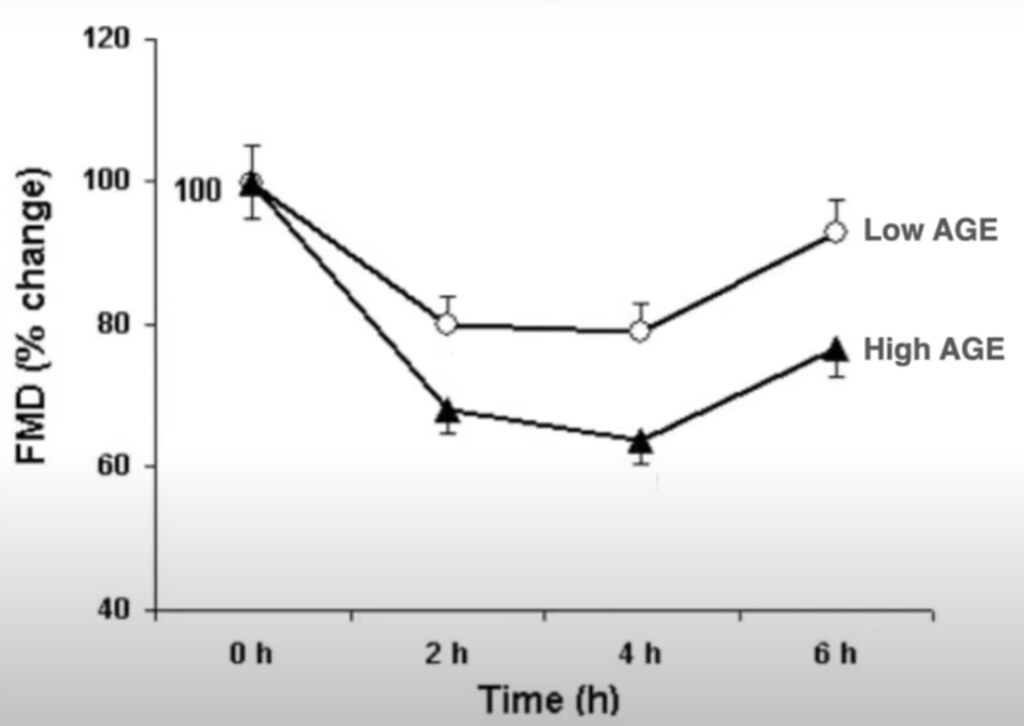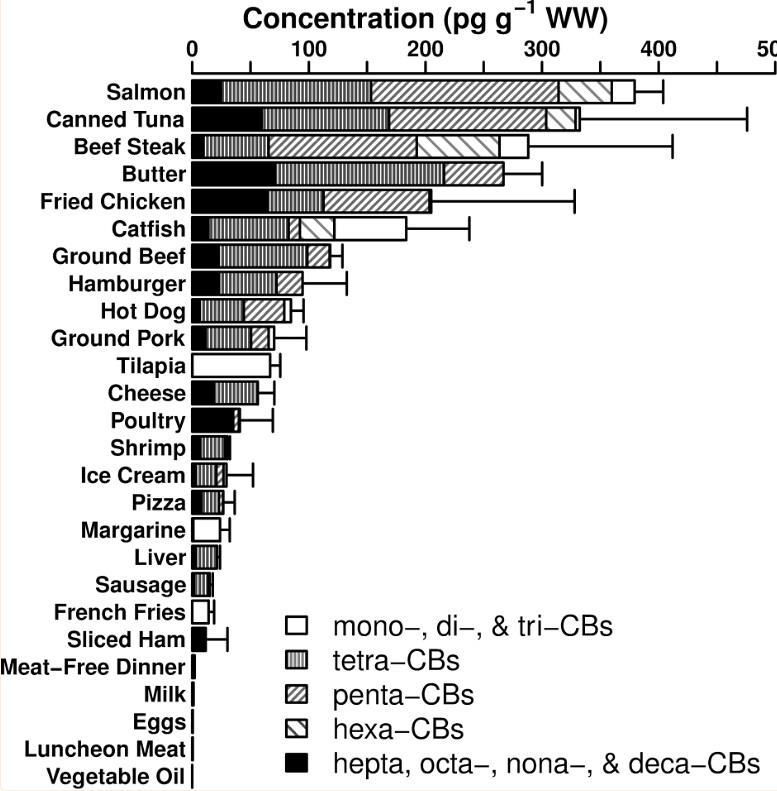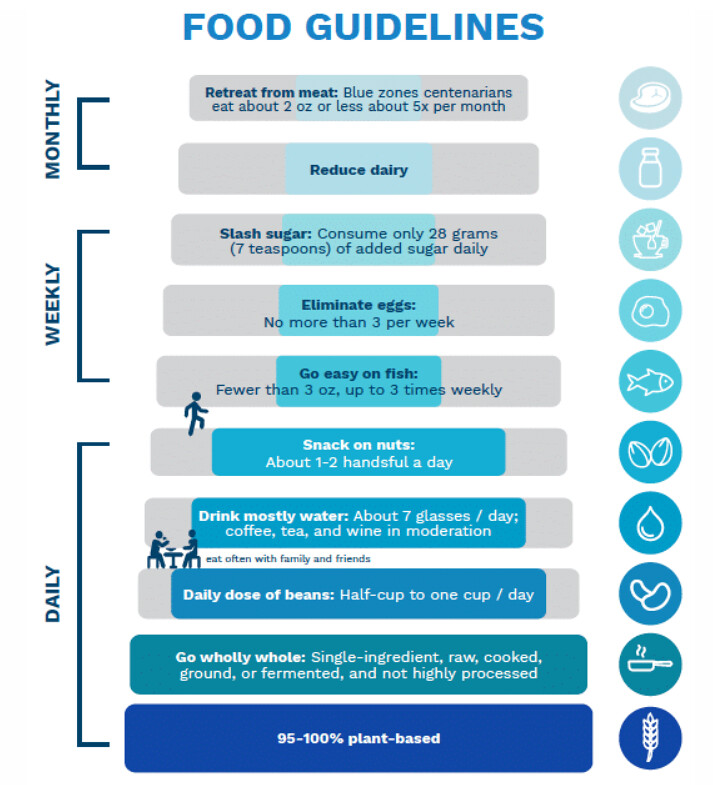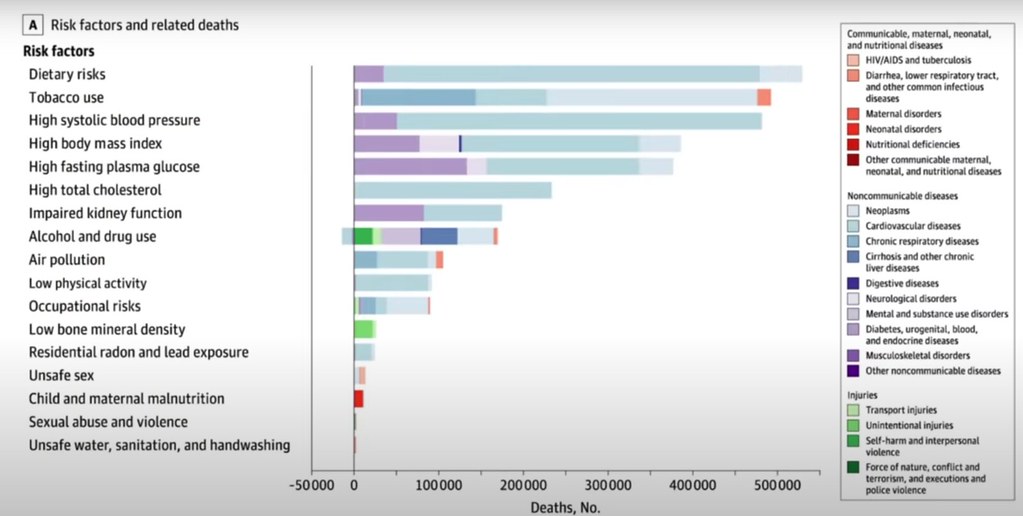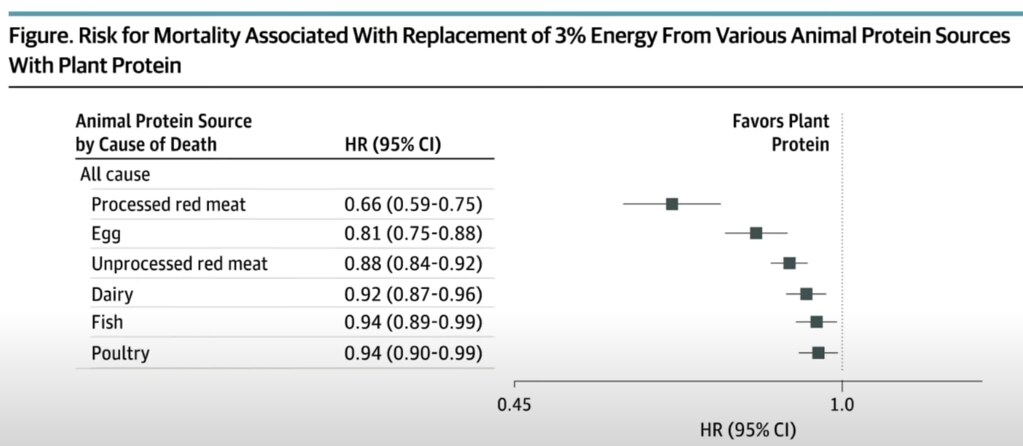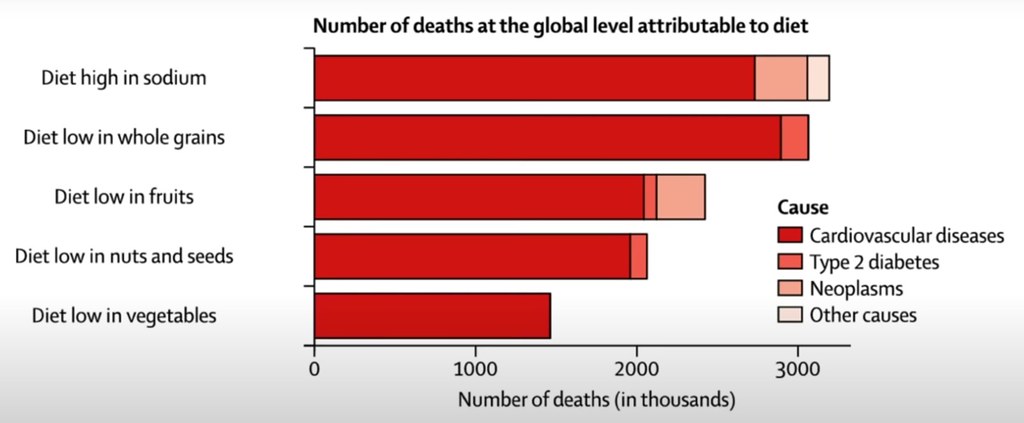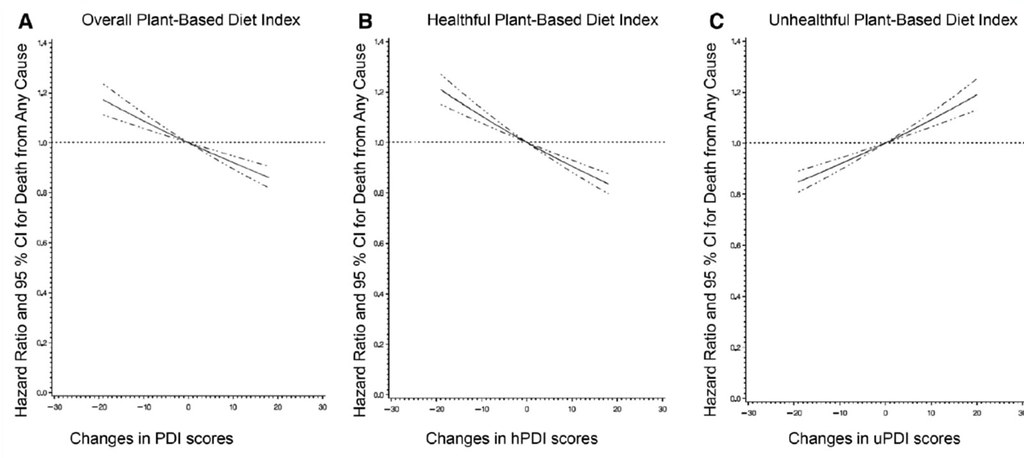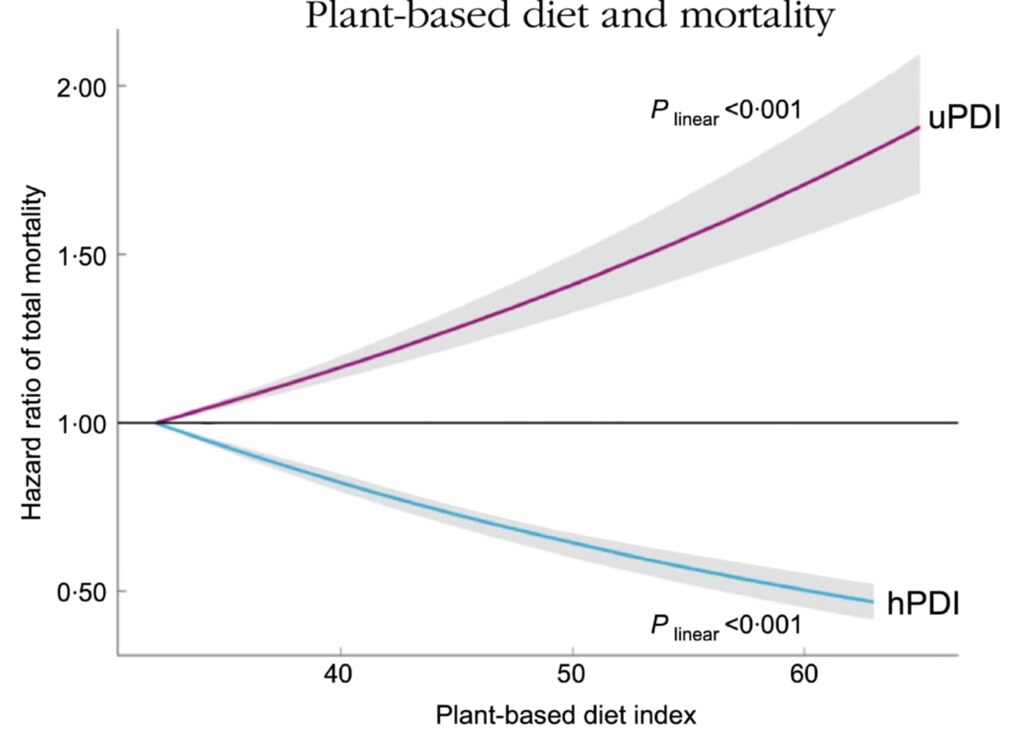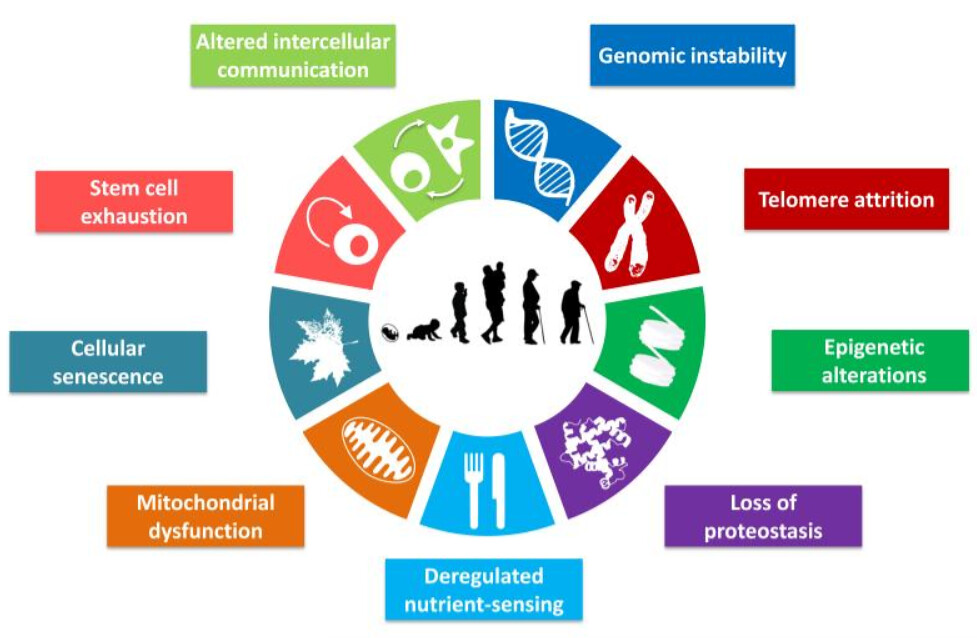This is the third post I’m writing on Dr. Greger’s presentation that kicks off his new book: How Not to Age. In this post, I will do a deep dive into three sections: Making meat safer – cooking methods, Eating fish, and Drinking alcohol. These sections of the video are summaries of three areas covered in Part II: Optimal Anti-Aging Regimen of How Not to Age. Again, any errors in the post are my mistakes; let me know and I will make corrections.
33:09 Making meat safer – cooking methods
- “WFPB [Whole-Food Plant-Based] diet has been shown to reduce the amount of gerontotoxins measured in the blood….”[46]
- Gerontotoxins. [47] Gerontotoxins, a contributor of systemic inflammation, are a group of toxins that cause our cells to age. A well-studied toxin is an advanced glycation end-product (AGE)
- Exogenous formation of AGEs
- AGEs are naturally occurring chemicals in raw animal-origin foods, and cooking propagates and accelerates the generation of more AGEs within them. Studies have shown that dry heating results in the formation of more than ten to hundred times of new AGEs in foods as compared to the uncooked state. [48]
- The reason for this high AGE content in red meats and poultry is probably given by the fact that, when cooked under dry heat, these release high amounts of highly reactive amino-lipids and reducing sugars, like fructose or glucose-6-phosphate, due to the rupture of lean muscle cells. [49]
- cooking methods can play a critical role in regulating the levels of AGE formation, with effects ranging from those caused by oven-frying > frying > broiling > roasting > boiling/poaching/stewing/steaming. For example, cooking meat (e.g., chicken, pork, or beef) by boiling or stewing can reduce the AGE contents to one-half of that prepared by broiling.[50]
- HAGE [high-AGE] and LAGE [low-AGE] meals
It showed that a single “real-life” HAGE meal induces a profound impairment of both macro- and microvascular function (−36.2% and −67.2%, respectively). These changes are significantly greater than those induced by a meal containing the same ingredients but with a five-fold lower AGE concentration (LAGE meal).[51]
- The AGE Less diet is the name given to diet with reduced AGEs. The AGE Less diet involves no caloric restriction and no medication. It involves avoiding the very worst foods (fried bacon) a reduction in very high AGE foods and cooking with moist heat instead of dry heat.
Although the science of AGEs is very well documented with over 8000 papers listed in PubMed, it is little known to both health care professionals and the general public. In an important regard, the science of AGEs shares a common characteristic with rapamycin; both have zero commercial value.[52] - Activated charcoal can block AGE levels.[53]
[35:38] Eating Fish
- Ocean pollution is a complex mixture of plastic waste, toxic metals, manufactured chemicals, oil spills, urban and industrial wastes, pesticides, fertilizers, pharmaceutical chemicals, agricultural runoff, and sewage….. Consumption of contaminated seafood is the main route of human exposure to chemical pollutants, HAB toxins, and plastic microparticles and microfibers in the oceans.[54]
- Fish, especially fatty fish, have long been viewed as a healthy dietary component because of their unique content of long-chain n-3 PUFA (n-3 fatty acids). ….
On the other hand, fish may also contain diverse environmental pollutants such as heavy metals and persistent organic pollutants (POP), including organochlorine pesticides, polychlorinated biphenyls (PCB), dioxins, polybrominated diphenylether (PBDE) and perfluorinated compounds (PFCO).[56] - Considering the accepted benefits of omega-3 fatty acids, failure to consistently observe beneficial effects of fish consumption may even be regarded as indirect evidence of harmfulness of contaminants in fish.[57]
- The resulting loss of intelligence causes diminished economic productivity that persists over the entire lifetime of these children. This lost productivity is the major cost of methyl mercury toxicity, and it amounts to $8.7 billion annually…[58]
- Mercury toxicity may be associated with cognitive decline diagnosed as Alzheimer’s disease.[59]
39:24 Drinking alcohol
- Globally, alcohol use was ranked as the seventh leading risk factor for premature death and disability in 2016… Our results show that the safest level of drinking is none.[60]
- The sick quitter skews results
…. the misclassification of former and occasional drinkers as abstainers is virtually the norm in alcohol epidemiology. …. individuals with poorer health are more likely to cut down or stop drinking completely. Such individuals are often still classified as ‘abstainers’ and used as a reference against which all current drinkers are compared. In simple terms, they make drinkers at all levels of consumption ‘look good’ by comparison.[61] - Estimates of mortality risk from alcohol are significantly altered by study design and characteristics. Meta-analyses adjusting for these factors find that low-volume alcohol consumption has no net mortality benefit compared with lifetime abstention or occasional drinking.[62]
- The sick quitter skews results
- The more alcohol, the more disease with no apparent protection at low levels of consumption.
- Even red wine….[63][64]
- Resveratrol treatment increased brain volume loss.[in an Alzheimer’s treatment study] [65]
- Healthiest beverages are water and tea
- Tea consumption reduces mortality
Dose-response analysis showed that an increment in tea consumption by three cups per day was related to a 24% reduction in total mortality (0.76, 0.63-0.91). Consumption of green tea and black tea were both associated with reduced total mortality, and an increase of one cup of green tea or black tea per day could reduce the risk of total mortality by 4% or 3%, respectively.[66] - Green tea may help prevent flu
Although several studies have reported that green tea catechins (GTCs) might prevent influenza virus infection, …. In a random-effects meta-analysis of five RCTs, 884 participants treated with GTCs showed statistically significant effects on the prevention of influenza infection compared to the control group….[67] - Green tea reduces the rate of DNA damage because it boosts activity of DNA repair enzymes [68]
- Green tea can increase DNA resistance to free radical damage More importantly, this increase in resistance to oxidant challenge was also seen in lymphocytes collected after 4 weeks’ supplementation with green tea. ….
- The results indicate that green tea has significant genoprotective effects and provide evidence for green tea as a ‘functional food’.[69]
- Tea consumption reduces mortality
References
- [46] Solway J, McBride M, Haq F, Abdul W, Miller R. Diet and Dermatology: The Role of a Whole-food, Plant-based Diet in Preventing and Reversing Skin Aging-A Review. J Clin Aesthet Dermatol. 2020 May;13(5):38-43. Epub 2020 May 1. PMID: 32802255; PMCID: PMC7380694. https://www.ncbi.nlm.nih.gov/pmc/articles/PMC7380694/
Cited as 6124 and 6211 in in How Not to Age Citations - [47] Gerontotoxins are also known as glycotoxins
- [48] Chen JH, Lin X, Bu C, Zhang X. Role of advanced glycation end products in mobility and considerations in possible dietary and nutritional intervention strategies. Nutr Metab (Lond). 2018 Oct 10;15:72. doi: 10.1186/s12986-018-0306-7. PMID: 30337945; PMCID: PMC6180645. https://www.ncbi.nlm.nih.gov/pmc/articles/PMC6180645/ Cited as references 684 and 701 in in How Not to Age Citations
- [49] Bettiga A, Fiorio F, Di Marco F, Trevisani F, Romani A, Porrini E, Salonia A, Montorsi F, Vago R. The Modern Western Diet Rich in Advanced Glycation End-Products (AGEs): An Overview of Its Impact on Obesity and Early Progression of Renal Pathology. Nutrients. 2019 Jul 30;11(8):1748. doi: 10.3390/nu11081748. PMID: 31366015; PMCID: PMC6724323. https://www.ncbi.nlm.nih.gov/pmc/articles/PMC6724323 Cited as references 682, 700 and 715 in in How Not to Age Citations
- [50] Rungratanawanich W, Qu Y, Wang X, Essa MM, Song BJ. Advanced glycation end products (AGEs) and other adducts in aging-related diseases and alcohol-mediated tissue injury. Exp Mol Med. 2021 Feb;53(2):168-188. doi: 10.1038/s12276-021-00561-7. Epub 2021 Feb 10. PMID: 33568752; PMCID: PMC8080618. https://www.ncbi.nlm.nih.gov/pmc/articles/PMC8080618/ Cited as references 726 and 733 in in How Not to Age Citations
- [51] Negrean M, Stirban A, Stratmann B, Gawlowski T, Horstmann T, Götting C, Kleesiek K, Mueller-Roesel M, Koschinsky T, Uribarri J, Vlassara H, Tschoepe D. Effects of low- and high-advanced glycation endproduct meals on macro- and microvascular endothelial function and oxidative stress in patients with type 2 diabetes mellitus. Am J Clin Nutr. 2007 May;85(5):1236-43. doi: 10.1093/ajcn/85.5.1236. Erratum in: Am J Clin Nutr. 2007 Oct;86(4):1256. PMID: 17490958. https://www.sciencedirect.com/science/article/pii/S0002916523280594 Cited as reference 753 in in How Not to Age Citations
- The 2 meals were isocaloric, had identical ingredients, and differed only by the temperature and time of cooking. Each meal consisted of 200 g chicken breast, 250 g potatoes, 100 g carrots, 200 g tomatoes, and 15 g vegetable oil and provided 580 kcal, 54 g protein, 17 g fat, 48 g carbohydrates, 60 mg cholesterol, and 10 g fibers. The HAGE meal (15.100 kU AGE) was prepared by frying or broiling at 230 °C for 20 min, whereas the LAGE meal (2750 kU AGE) was prepared by steaming or boiling at 100 °C for 10 min. The subjects were instructed to eat the test meal within 30 min.
- [52] Green AS. mTOR, glycotoxins and the parallel universe. Aging (Albany NY). 2018 Dec 12;10(12):3654-3656. doi: 10.18632/aging.101720. PMID: 30540565; PMCID: PMC6326656. https://www.ncbi.nlm.nih.gov/pmc/articles/PMC6326656/ Cited as references 681, 687, 696, 827, 833 and 834 in in How Not to Age Citations
- A great quote in this paper: “…the widespread treatment to slow aging by physicians has not happened. For most people anti-aging treatment is like, “Do-it-yourself Brain Surgery.”
- Also a useful conclusion: “I consider the combined use of oral intermittent rapamycin and the AGE Less diet to have the best potential to treat aging. However, I do not expect either to become very popular as they both suffer from the same fatal flaw. Rapamycin is a generic drug. The AGE Less diet is just cooking the same foods with low moist heat. However, until a super expensive new anti-aging drug comes along that can make Big Pharma 50 billion dollars a year, generic rapamycin and the AGE Less diet will do quite well.”
- [53] Yamagishi S, Nakamura K, Matsui T, Inoue H, Takeuchi M. Oral administration of AST-120 (Kremezin) is a promising therapeutic strategy for advanced glycation end product (AGE)-related disorders. Med Hypotheses. 2007;69(3):666-8. doi: 10.1016/j.mehy.2006.12.045. Epub 2007 Feb 28. PMID: 17331665. Cited as reference 829 in How Not to Age Citations
- [54] Landrigan PJ, Stegeman JJ, Fleming LE, Allemand D, Anderson DM, Backer LC, Brucker-Davis F, Chevalier N, Corra L, Czerucka D, Bottein MD, Demeneix B, Depledge M, Deheyn DD, Dorman CJ, Fénichel P, Fisher S, Gaill F, Galgani F, Gaze WH, Giuliano L, Grandjean P, Hahn ME, Hamdoun A, Hess P, Judson B, Laborde A, McGlade J, Mu J, Mustapha A, Neira M, Noble RT, Pedrotti ML, Reddy C, Rocklöv J, Scharler UM, Shanmugam H, Taghian G, van de Water JAJM, Vezzulli L, Weihe P, Zeka A, Raps H, Rampal P. Human Health and Ocean Pollution. Ann Glob Health. 2020 Dec 3;86(1):151. doi: 10.5334/aogh.2831. PMID: 33354517; PMCID: PMC7731724. https://pubmed.ncbi.nlm.nih.gov/33354517/ Not listed in in How Not to Age Citations
- [55] Saktrakulkla P, Lan T, Hua J, Marek RF, Thorne PS, Hornbuckle KC. Polychlorinated Biphenyls in Food. Environ Sci Technol. 2020 Sep 15;54(18):11443-11452. doi: 10.1021/acs.est.0c03632. Epub 2020 Sep 3. PMID: 32816464; PMCID: PMC7759298.https://www.ncbi.nlm.nih.gov/pmc/articles/PMC7759298/
Not listed in in How Not to Age Citations- Full Caption: Figure 2. PCB concentrations in foods (pg g−1 WW), calculated as the sum of the mean of the congeners measured in triplicate in each food item. The error bars indicate the standard deviation. Salmon was wild caught frozen; catfish and tilapia were farmed frozen; liver was beef and chicken; meat-free dinner was a mixture of frozen macaroni-and-cheese and tortillas; milk was 2%; and luncheon meat was ham and turkey breast.
- [56] Ruzzin, J., & Jacobs, D. (2012). The secret story of fish: Decreasing nutritional value due to pollution? British Journal of Nutrition, 108(3), 397-399. doi:10.1017/S0007114512002048 https://www.cambridge.org/core/journals/british-journal-of-nutrition/article/secret-story-of-fish-decreasing-nutritional-value-due-to-pollution/EC4D6FCCCCD08ABB04A75794B2D1DF5D
Not listed in in How Not to Age Citations - [57]Lee DH, Jacobs DR Jr. Inconsistent epidemiological findings on fish consumption may be indirect evidence of harmful contaminants in fish. J Epidemiol Community Health. 2010 Mar;64(3):190-2. doi: 10.1136/jech.2009.093328. PMID: 20203120. Behind paywall but preview of first page available at https://www.jstor.org/stable/20721168
Not listed in in How Not to Age Citations - [58] Trasande L, Landrigan PJ, Schechter C. Public health and economic consequences of methyl mercury toxicity to the developing brain. Environ Health Perspect. 2005 May;113(5):590-6. doi: 10.1289/ehp.7743. PMID: 15866768; PMCID: PMC1257552. https://www.ncbi.nlm.nih.gov/pmc/articles/PMC1257552/
Not listed in in How Not to Age Citations - [59] Foley MM, Seidel I, Sevier J, Wendt J, Kogan M. One man’s swordfish story: The link between Alzheimer’s disease and mercury exposure. Complement Ther Med. 2020 Aug;52:102499. doi: 10.1016/j.ctim.2020.102499. Epub 2020 Jul 2. PMID: 32951747. Behind partial paywall, cited as 5490 in How Not to Age Citations
- [60]
- GBD 2016 Alcohol Collaborators. Alcohol use and burden for 195 countries and territories, 1990-2016: a systematic analysis for the Global Burden of Disease Study 2016. Lancet. 2018 Sep 22;392(10152):1015-1035. doi: 10.1016/S0140-6736(18)31310-2. Epub 2018 Aug 23. Erratum in: Lancet. 2018 Sep 29;392(10153):1116. Erratum in: Lancet. 2019 Jun 22;393(10190):e44. PMID: 30146330; PMCID: PMC6148333. https://www.ncbi.nlm.nih.gov/pmc/articles/PMC6148333/
Cited as 661, 2298. 2299, and 2350 in How Not to Age Citations - [61] Stockwell T, Zhao J. Alcohol’s contribution to cancer is underestimated for exactly the same reason that its contribution to cardioprotection is overestimated. Addiction. 2017 Feb;112(2):230-232. doi: 10.1111/add.13627. Epub 2016 Nov 27. PMID: 27891690. https://onlinelibrary.wiley.com/doi/10.1111/add.13627
Cited as 2318 in How Not to Age Citations - [62]
- Stockwell T, Zhao J, Panwar S, Roemer A, Naimi T, Chikritzhs T. Do “Moderate” Drinkers Have Reduced Mortality Risk? A Systematic Review and Meta-Analysis of Alcohol Consumption and All-Cause Mortality. J Stud Alcohol Drugs. 2016 Mar;77(2):185-98. doi: 10.15288/jsad.2016.77.185. PMID: 26997174; PMCID: PMC4803651. https://www.ncbi.nlm.nih.gov/pmc/articles/PMC4803651/
Cited as 2320 in How Not to Age Citations - [63] Williams MJ, Sutherland WH, Whelan AP, McCormick MP, de Jong SA. Acute effect of drinking red and white wines on circulating levels of inflammation-sensitive molecules in men with coronary artery disease. Metabolism. 2004 Mar;53(3):318-23. doi: 10.1016/j.metabol.2003.10.012. PMID: 15015143. Cited as 2359 in How Not to Age Citations
- [64] Naissides M, Mamo JC, James AP, Pal S. The effect of acute red wine polyphenol consumption on postprandial lipaemia in postmenopausal women. Atherosclerosis. 2004 Dec;177(2):401-8. doi: 10.1016/j.atherosclerosis.2004.07.025. PMID: 15530916. Cited as 2358 in How Not to Age Citations
- [65] R. Scott Turner, Ronald G. Thomas, Suzanne Craft, Christopher H. van Dyck, Jacobo Mintzer, Brigid A. Reynolds, James B. Brewer, Robert A. Rissman, Rema Raman, Paul S. Aisen, A randomized, double-blind, placebo-controlled trial of resveratrol for Alzheimer disease For the Alzheimer’s Disease Cooperative Study Neurology Oct 2015, 85 (16) 1383-1391; DOI: 10.1212/WNL.0000000000002035 https://n.neurology.org/content/85/16/1383
Not listed in in How Not to Age Citations - [66]
